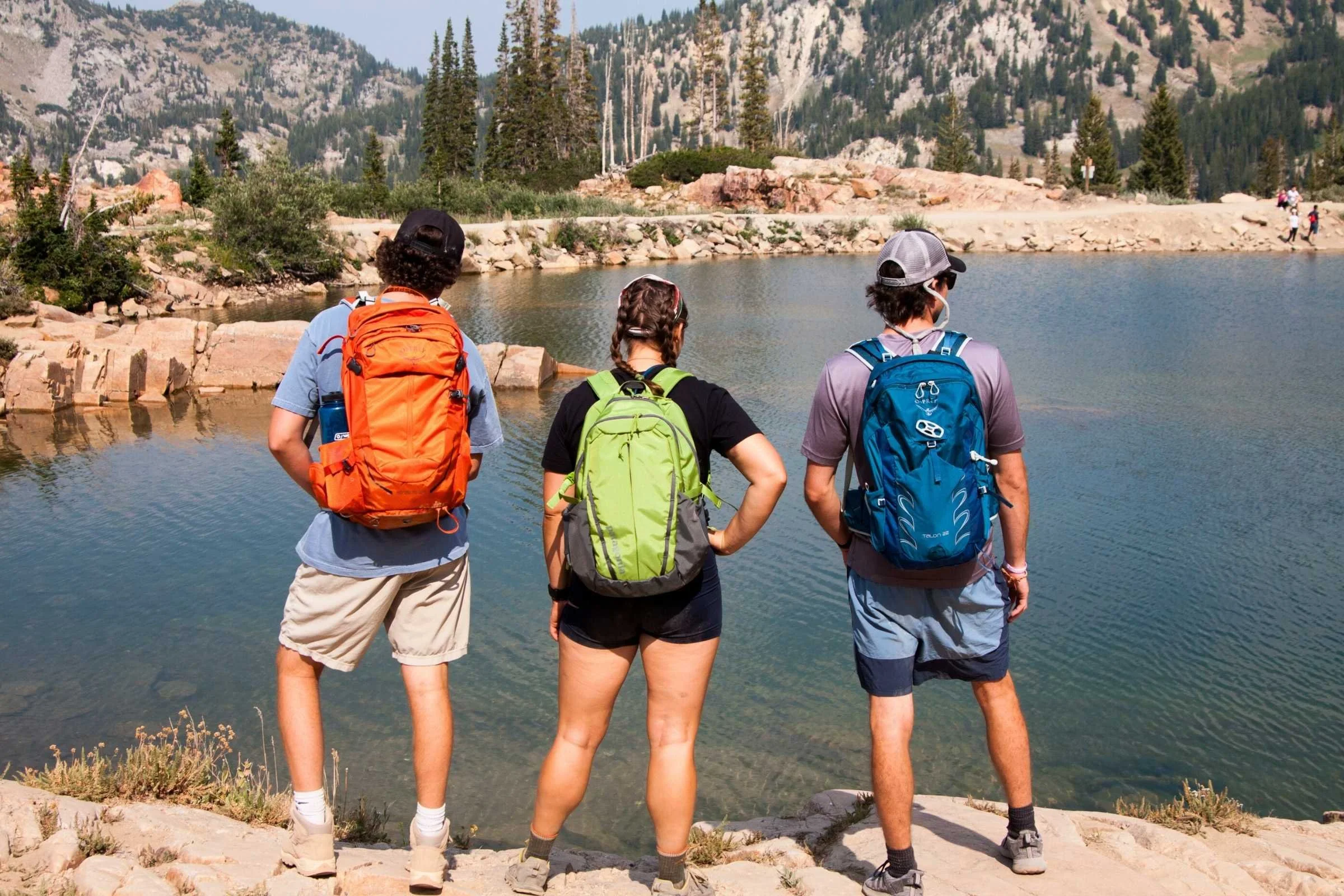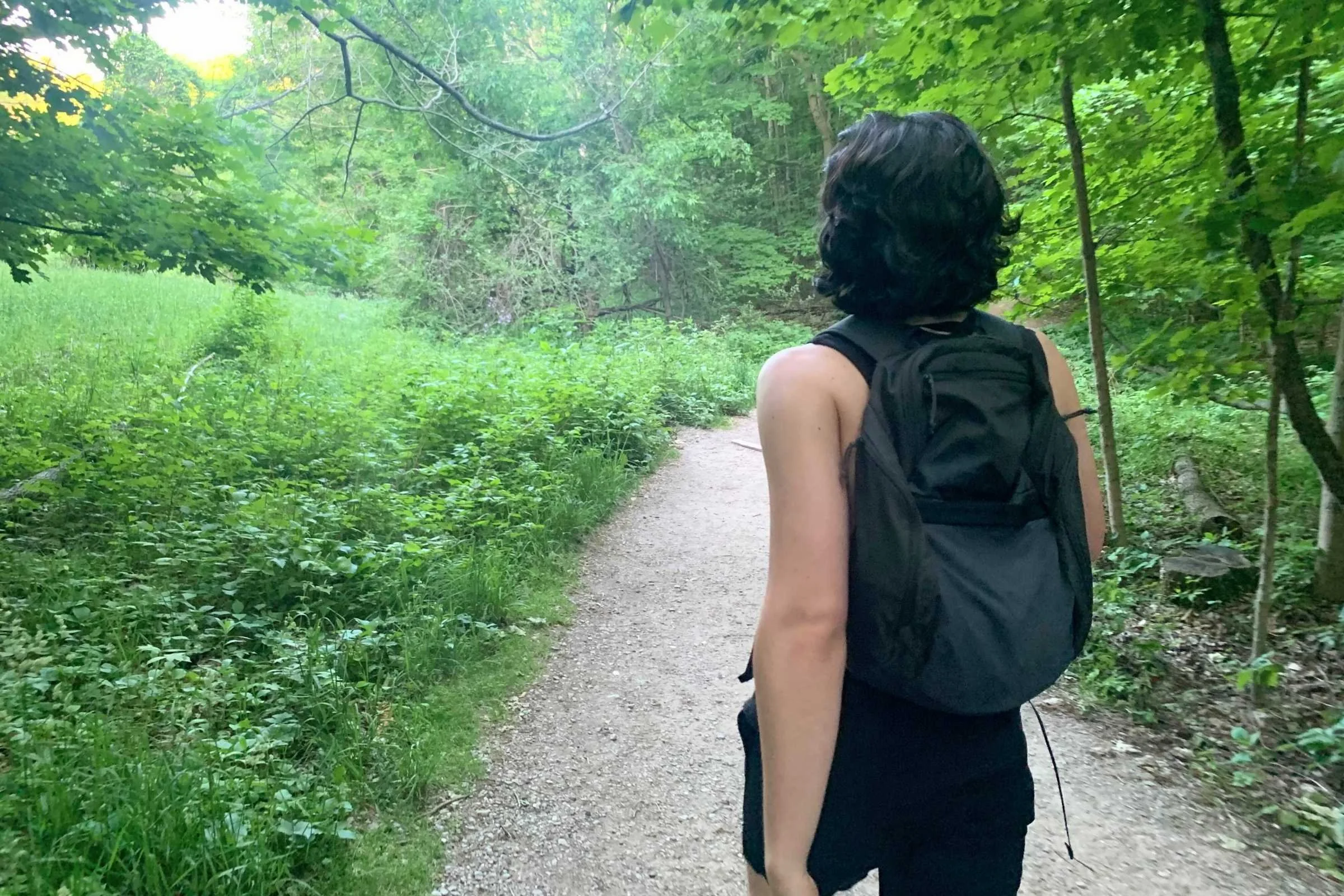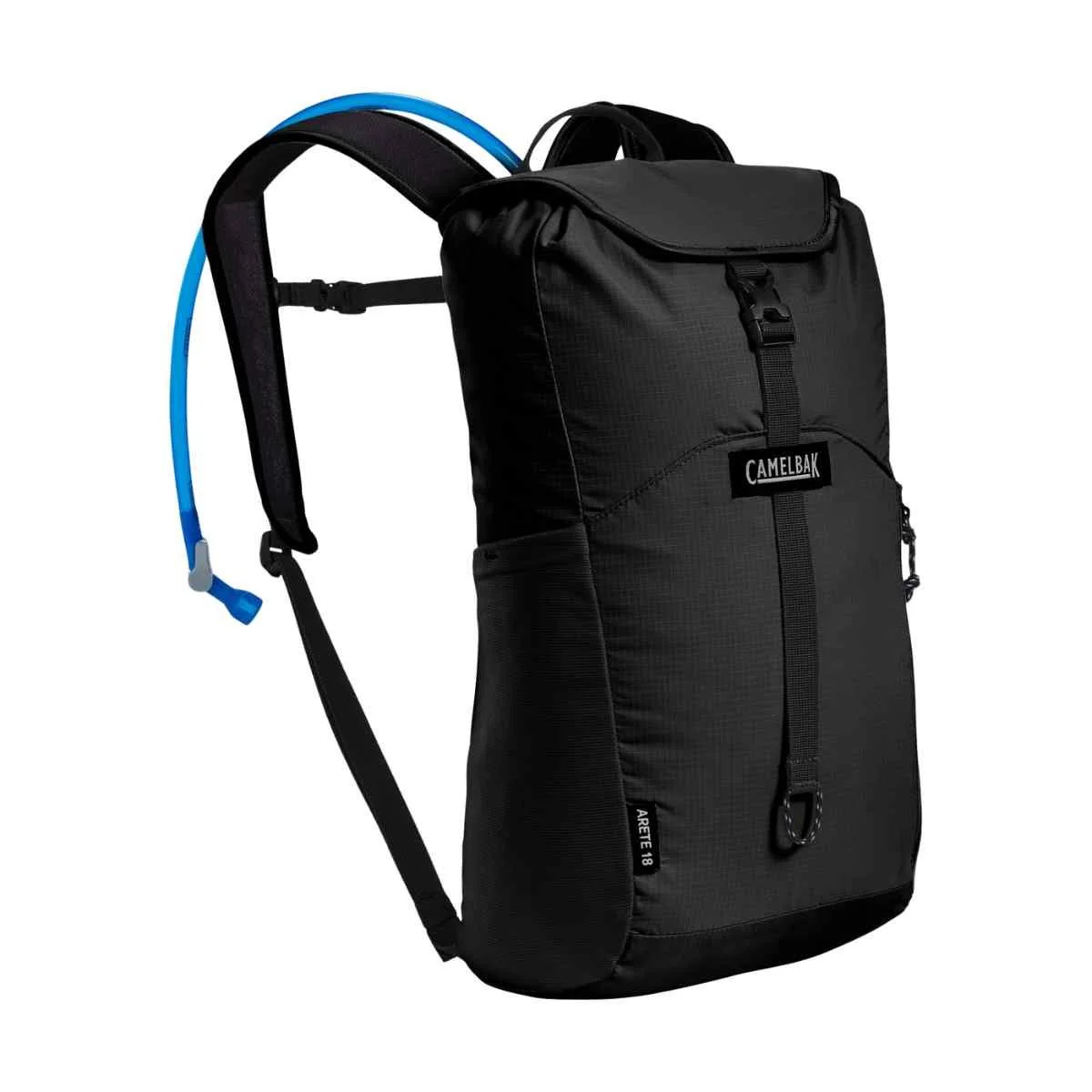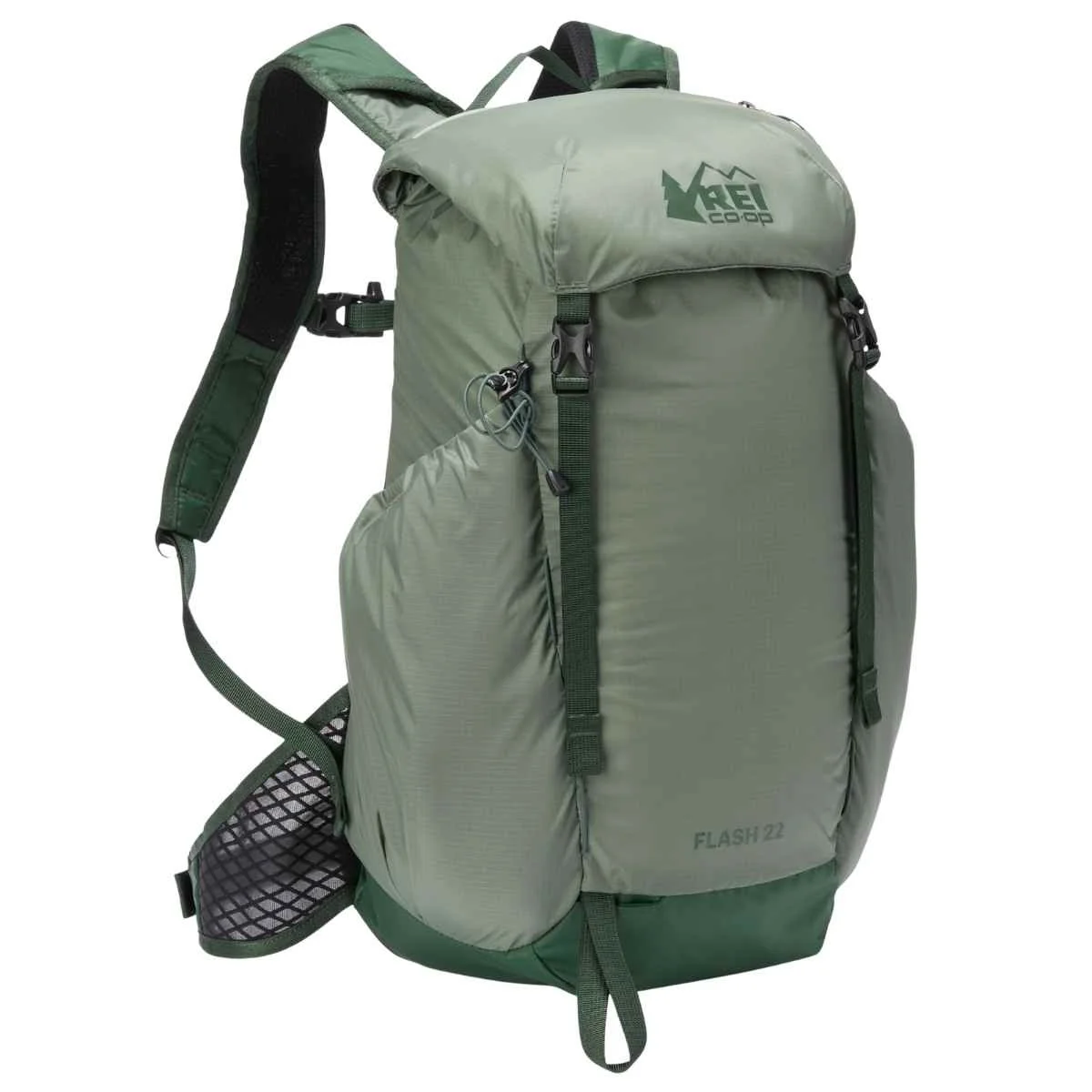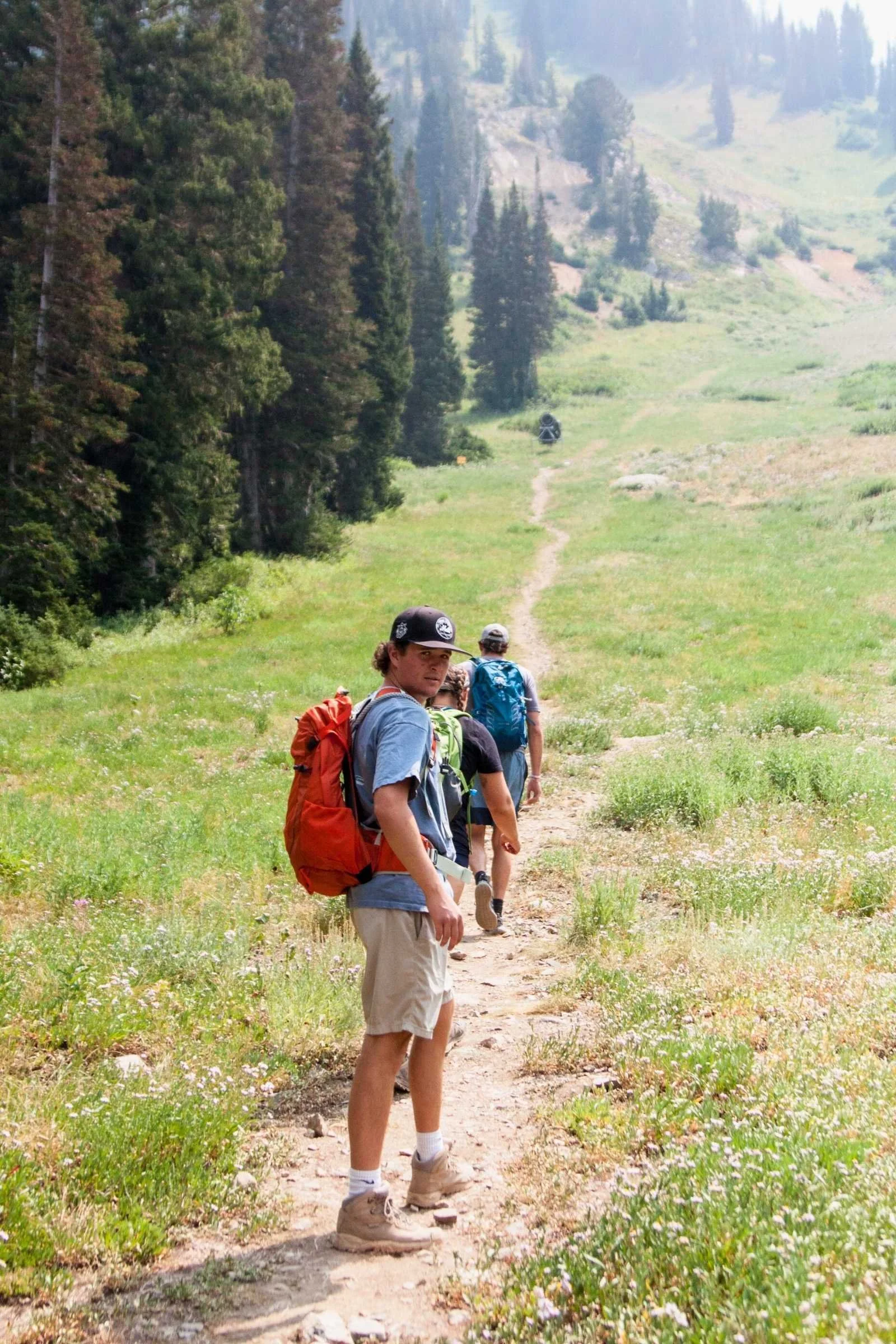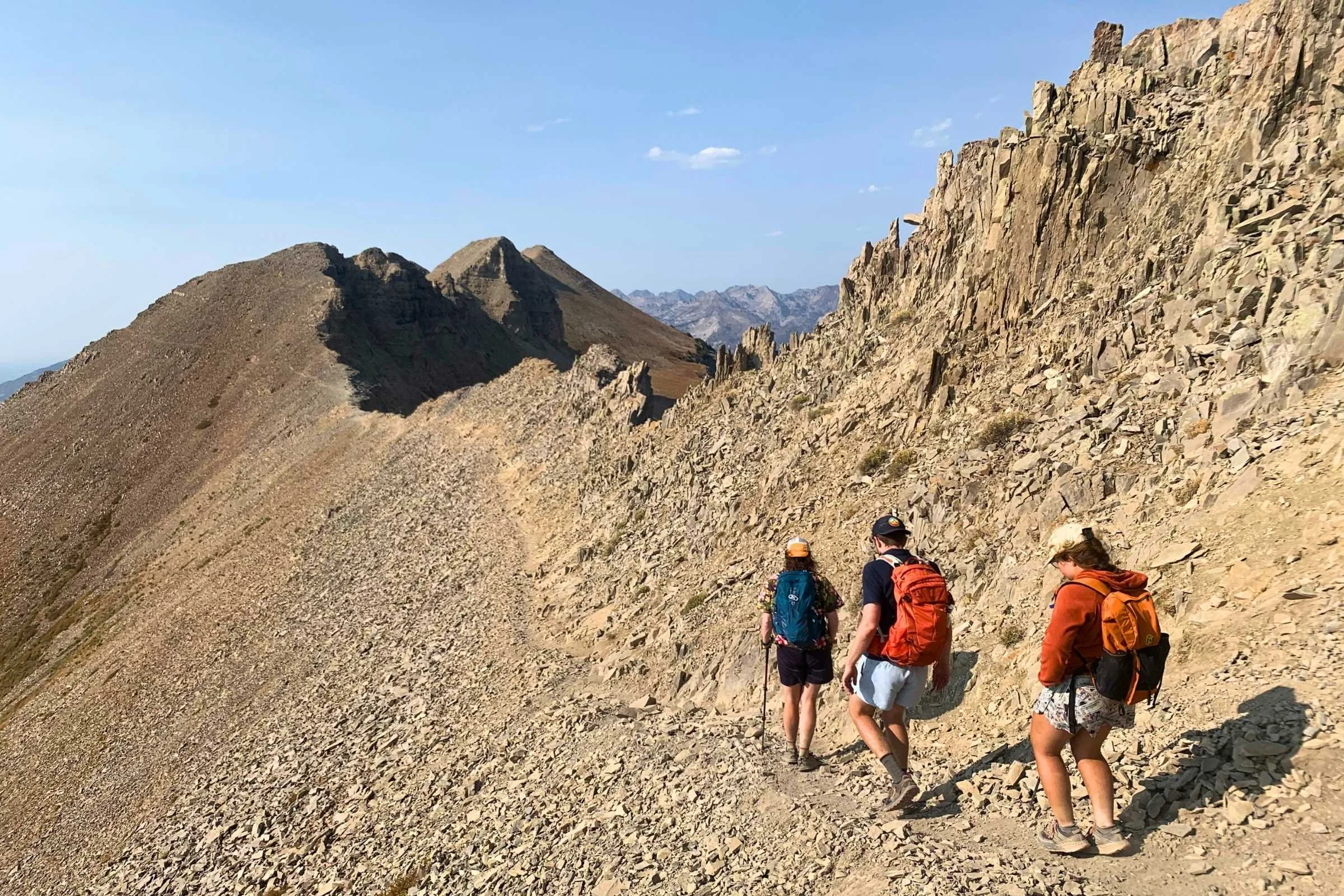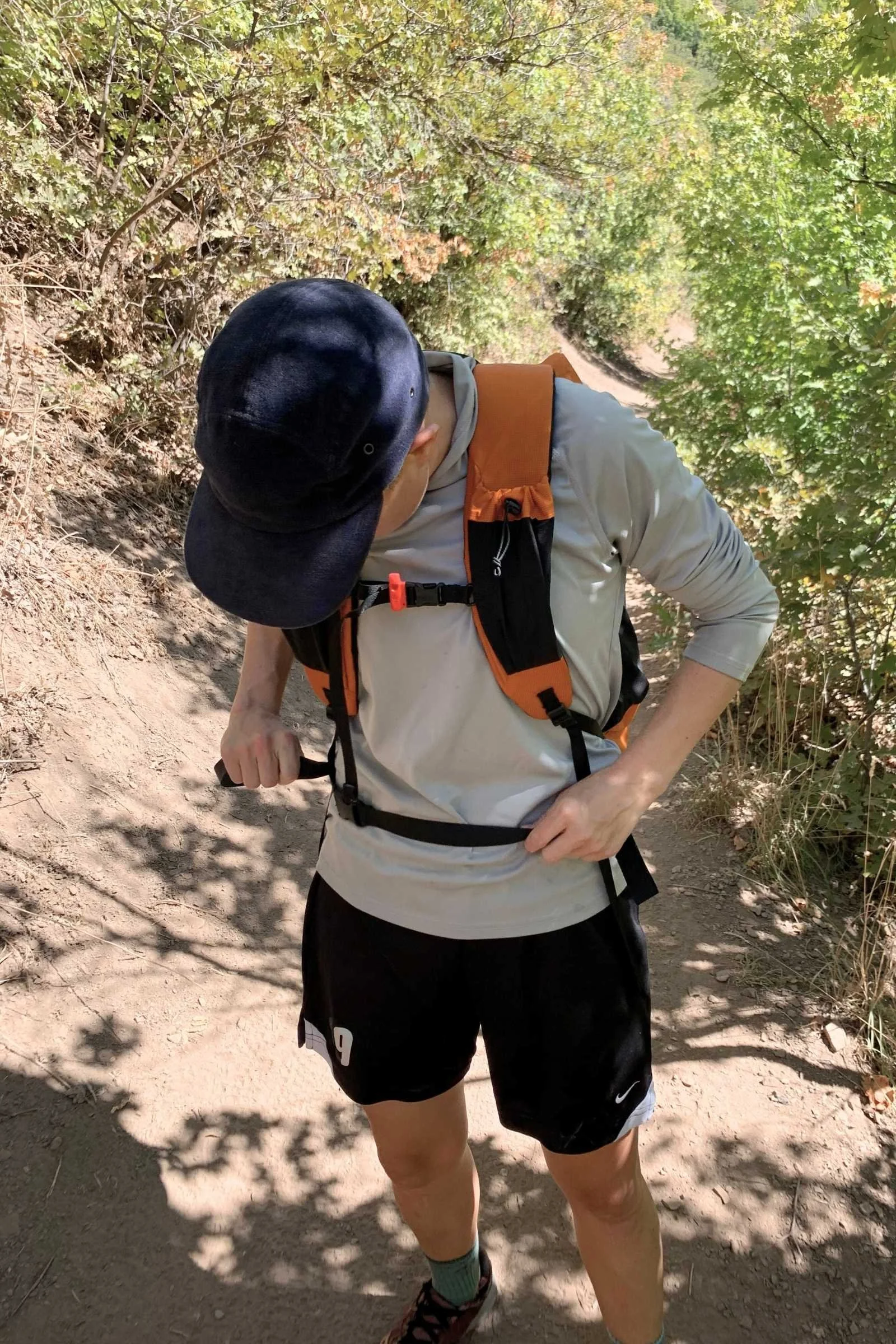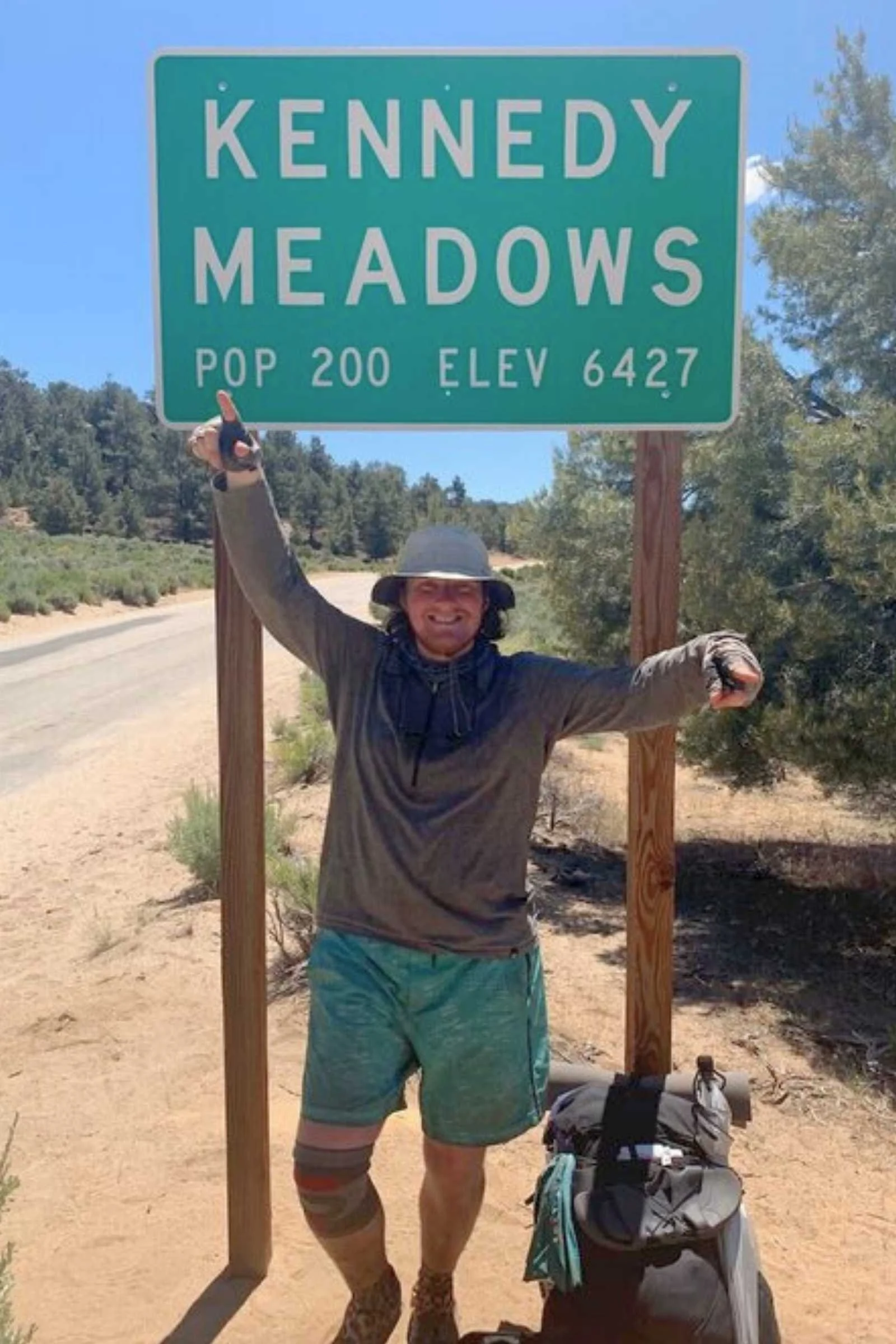Best Daypacks for Hiking of 2025
The Top Small, Packable, Ultralight, and Heavy-Load Daypacks for Hiking
Updated July 26th, 2025, with 3 new winners, updates on designs and material, and updates on what to look for and FAQs
Home > Gear Reviews > Hiking
To find the best daypacks for hiking, we researched 64 of the most promising hiking backpacks. Then we tested 21 daypacks from humid beach hikes in Michigan to rugged mountain summits in Utah, Idaho, and Wyoming. The best hiking packs were comfortable and easy to use — whether you are experienced or on your first trail.
Our testers agreed on 8 hiking packs that experts and new hikers alike found stable, ventilating, and well-organized. These are the best daypacks we found at various volumes, budgets, and weight carrying capacities, so you can hike the trails feeling comfortable and well-equipped for your adventure.
The best daypacks for hiking feature the Osprey Talon 22 (men's) and Tempest 20 (women's) as our overall winners, offering superior versatility, durability, and comfortable suspension systems that excel from casual state park walks to aggressive fourteener summit attempts.
While different bodies and different hikes call for different backpack features, we tested over 4 years and at least a thousand miles of trails to find the best backpacks for hikers.
Headed on an overnighter? See our guide to Best Backpacking Backpacks
Hiking with a Little One? See our guide to Best Baby and Toddler Hiking Carriers
We create reader-supported, objective gear reviews independently selected by our editors. This story may contain affiliate links, which help fund our website. When you click on the links to purchase gear, we may get a commission, without costing you an extra cent. Thank you for supporting our work and mission of outdoor coverage for every body! Learn more.
Comparison Tables
Features
| DAYPACKS | TREELINE AWARD | MSRP* | CAPACITY | WEIGHT | FRAME? | PACK LOADING |
|---|---|---|---|---|---|---|
| Osprey Talon 22 | Best Overall (men's version) Read why |
$160 | 22 L | 2 lb 6.1 oz | Internal frame | Front panel |
| Osprey Tempest 22 (Women's) | Best Overall (women's version) Read why |
$160 | S/M: 22 L XS/S: 20 L | 2 lbs. 6.1 oz. | Internal frame | Front panel |
| Hyperlite Mountain Gear Daybreak | Best Ultralight Read why |
$229 | 17 L | 1 lb 4.9 oz | Frameless | Top |
| Granite Gear Dagger Pack | Best Budget Read why |
$120 | 22 L | 1 lb 8 oz | Internal frame | Top |
| Six Moon Designs Wy'east | Best High Volume Read why |
$185 | 30 L | 1 lb 9 oz | Frameless | Top |
| Osprey Stratos 24 | Best for Heavy Loads Read why |
$180 | 24 L | 2 lbs 12 oz | Internal frame | Front panel |
| Osprey Sirrus 24 (Women's) | Best for Heavy Loads Read why |
$180 | 24 L | 2 lbs 11.5 oz | Internal frame | Front panel |
| Patagonia Refugio | Best School Backpack Read why |
$109 | 28 L | 1 lb 9.9 oz | Frameless | Front panel |
Price and Dimensions
| DAYPACKS | TREELINE AWARD | ADJUSTABLE TORSO LENGTH? | FITS WAISTS | TORSO LENGTH | HIPBELT POCKETS? | RAINCOVER INCLUDED? |
|---|---|---|---|---|---|---|
| Osprey Talon 22 | Best Overall (men's version) Read why |
Yes | 29-50 in, Extended fit 40-70 in | 17-22 in | Yes | No |
| Osprey Tempest 22 (Women's) | Best Overall (women's version) Read why |
Yes | 26-70 in | 13-19.5 in | Yes | No |
| Hyperlite Mountain Gear Daybreak | Best Ultralight Read why |
No | n/a | n/a | No | No |
| Granite Gear Dagger Pack | Best Budget Read why |
No | n/a | 18-21 in | No | No |
| Six Moon Designs Wy'east | Best High Volume Read why |
No | 22-55 in | n/a | Yes, pockets no | No |
| Osprey Stratos 24 | Best for Heavy Loads Read why |
Yes | 28-50 in | 18-22 in | Yes | Yes |
| Osprey Sirrus 24 (Women's) | Best for Heavy Loads Read why |
Yes | 26-50 in | 15-19 in | Yes | Yes |
| Patagonia Refugio | Best school backpack Read why |
No | No waistbelt | n/a | No | No |
See our most popular hiking articles or see all our Hiking Gear Guides:
The Best Daypacks
The Best Overall Daypack: Osprey Talon 22 (Men’s) and Tempest 22 (women’s)
Weight: 2 lb 6.1 oz
Fits waist: 29-50 in, Extended fit 40-70 in
Fits torso: 17-22 in
Capacity: 22L (also comes in in 44L, 36L, 20L and 11L)
Hipbelt: Yes, BioStretch harness and continuous wrap hipbelt
What we liked: Diverse features for multiple activities that don’t take away from the pack’s performance
What we didn’t like: Size of the pockets leaves much to be desired
The men’s Osprey Talon 22 and Tempest 22 are the best hiking daypacks on the market for their versatility, durability, and comfortable fit and suspension.
These Osprey packs worked well on all different types of day hikes: whether a class 4 summit of a fourteener or a casual day hike at your local state park, this pack can do it all.
We found the Talon’s 22L of carrying capacity to be the perfect amount of space: enough for a couple layers, plenty of snacks, and ample water to get you through many miles. Osprey's Custom Fit Philosophy suspension has the right amount of back support to make any load feel lighter than it actually is.
Compare Prices Of The Osprey Talon And Tempest
Men's
Women's
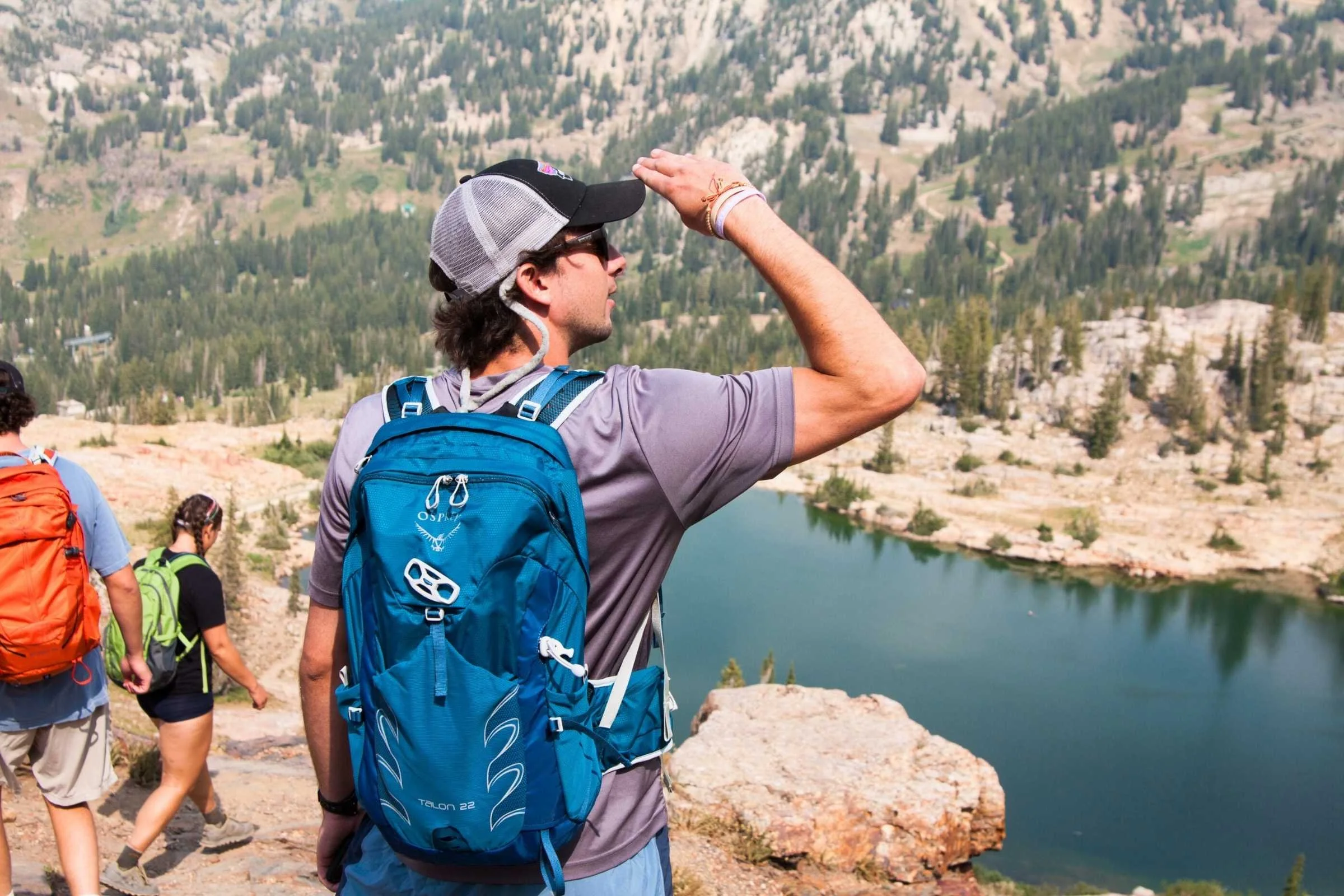
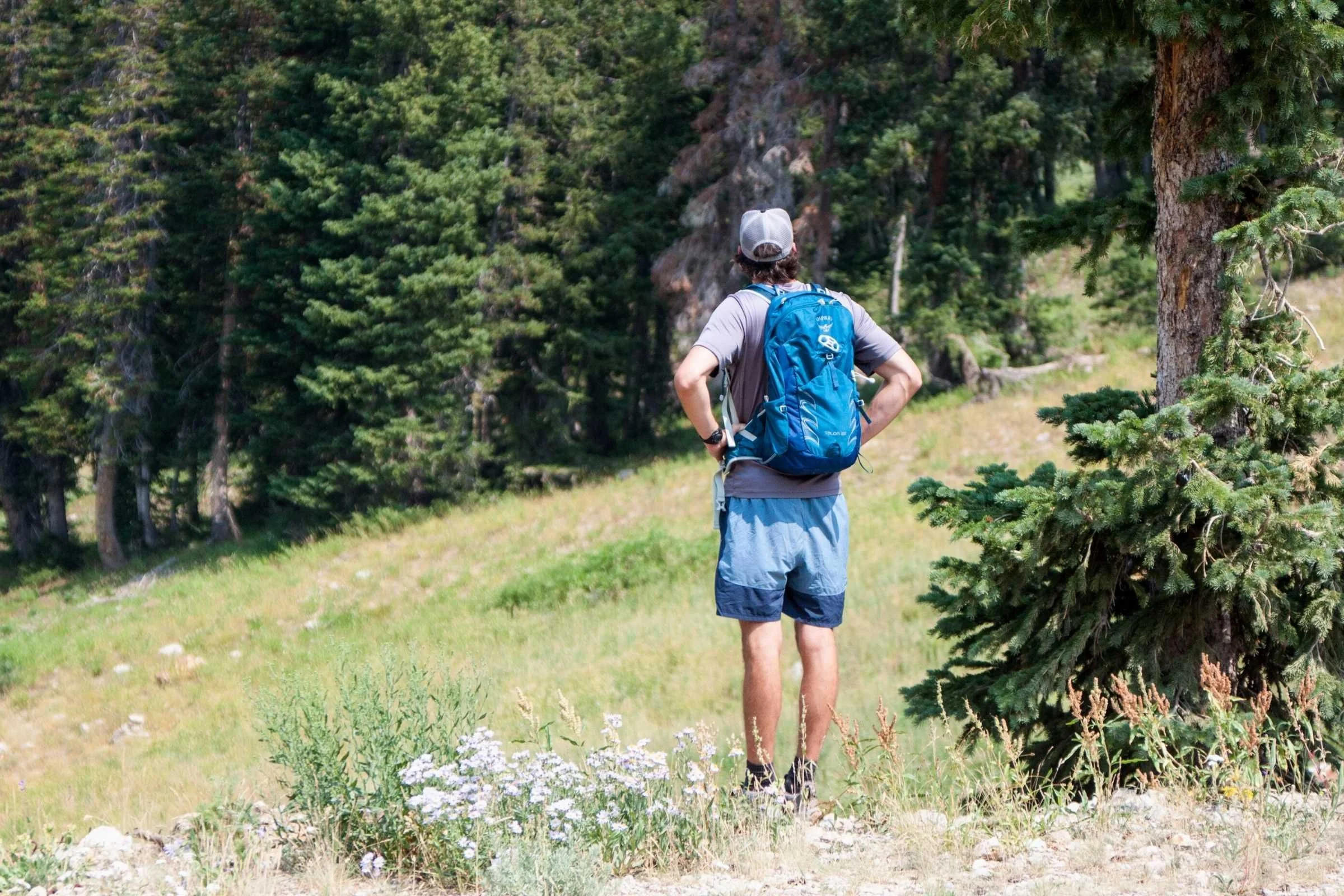

Many different features make this Osprey backpack the best overall daypack:
Comfortable hip belt, with decent sized pockets for carrying snacks, maps, ID, keys, and other small items
An ice axe loop, for tougher trips that might require self-arrest
Lower inside out carry straps
This is the compression strap on the side of your pack that can be used to carry loose items like a pair of sandals. It can also be used to compress the pack to secure the carrying load
Dual-zipper panel access to the main compartment, for more flexibility in opening the pack for lefties
An external hydration sleeve, so you don’t have to dig into the pack to access your water bladder
Stow-on-the-go trekking pole carriers, for easier storage when you don’t need your poles or easy access when you do
A Large mesh front pocket, for items that need to dry out but stay secure
A helmet carrier, to encourage safety in the high country around loose, falling rocks
Secure sternum strap with built-in whistle.
We think this pack is a good choice for anyone looking for an all in one daypack to use on a variety of hikes from around town to aggressive peak bagging.
We tested the Osprey Talon by hiking in the Utah Wasatch Range and Unitas Range and the Northern Michigan dunes. We tested in varied climates, terrains, and difficult of day hikes — from a 15-mile summit in Utah as well a three-mile hike to the beach in Michigan.
Our testers on this backpack had anywhere from 20 miles to 5000 miles of hiking experiences. Every hiker — no matter their experience level — really loved the carry and feel of the Talon. They all commented on the comfort of the pack. The hip belt on the Talon is beyond comfortable.
In the last few years, Osprey released the Osprey Tempest 20, the women’s version of the Talon. It comes in a extra small/small sizing for folks with smaller torsos and a small/medium sizing (so isn’t available in large or extra large like the Talon). It features a women-specific BioStretch harness and continuous wrap around hipbelt to draw the weight towards the hips where most women find their balance of gravity. If you find you have a smaller torso and are eyeing the Talon, we’d recommend the Tempest as an alternative.
The only downside to the Talon is the size of pockets — an issue on most Osprey packs. The side pockets can fit a Nalgene, but it is very tight. Can sometimes make water access while hiking pretty difficult. The built-in shoulder strap pocket can’t fit more than a granola bar. A smartphone won’t fit anywhere but in the main pocket of the bag, where it risks getting “lost” in the big space.
Best Ultralight Daypack: Hyperlite Mountain Gear Daybreak
Weight: 1 lb 4.9 oz
Fits waist: 26-70 in
Fits torso: 13-19.5 in
Capacity: 17L
Hipbelt: Yes, stowable
What we liked: The water-resistant zippers and Dyneema material mean no worries in the rain
What we didn’t like: The high-ticket price can be off-putting for some
The Hyperlite Mountain Gear Daybreak has been making great ultralight backpacking packs for years and this day hiking pack is no exception. It’s the only pack we tested that’s made of Dyneema Composite Fabric (formerly called cuben fiber), an incredibly water-resistant fabric that’s able to withstand thousands of miles of wear and tear. It’s a similar fabric to what HMG uses in the Junction backpack, our Upgrade winner in our Best Backpacking Backpacks story. While neither pack is not marketed as a 100% waterproof backpack, we think it's pretty close.
View The Hyperlite Mountain Gear Daybreak
I’m a fan of the comfortable hip belt and the added touch of water-resistant zippers that help to keep your gear dry in that (un)expected weather.
I do wish the Daybreak came in Hyperlite’s signature white color, but the black looks sleek and low-profile enough that it can work in an urban setting, too. Its packable enough to double as a travel daypack to store in luggage and bring out for urban adventures or post-workday hikes.
We tested the Daybreak on day hikes in Utah’s Wasatch Range, Unita Range, and the Northern Michigan dunes. We carried this hiking pack on hikes of a variety of difficulties, from a 15-mile summit of Mount Timpanogos to a three-mile hike to the beach in Northern Michigan.
Our testers have anywhere from 20 miles to 5,000 miles of hiking experiences. I took the Daybreak on a the sandy but short hike in the dunes of Northern Michigan. I really enjoyed it. The outside pocket was great for many snacks and easy quick access. The hipbelt provided enough support for an all-day load (also love the ability to hide the hipbelt). The zipper enclosure did a good job of keeping things less sandy than other packs probably would have.
Hyperlite packs are known for being expensive, though — and the Daybreak is no exception.
Though the pack looks nice enough to go from trail to town — the hip belt tucks into the back panel, and the hydration sleeve will fit a 13” laptop or tablet — it’s still double the price of our Budget pick.
We realize some of the extra cost comes from the Daybreak is made in the USA, the only pack that we considered that has that accolade.
Still, if you’re looking for an ultralight, waterproof backpack that can handle whatever you throw at it — and that you won’t have to replace any time soon — the Hyperlite Mountain Gear Daybreak is for you.
Best Budget Daypack: Granite Gear 22L Dagger
Weight: 1 lb 8oz
Fits waist: n/a
Fits torso: 18-21 in
Capacity: 22L
Hipbelt: No
What we liked: Hard-working daypack for the price, great value for the price
What we didn’t like: Hip belt construction is a little flimsy, doesn’t provide as much support as you would hope
The Granite Gear 22L Dagger is easy to get hyped about — it’s a very well-built hiking daypack designed to last many miles of trail and survive rough travel. We think for the price, you can’t find a more durable and easy-to-use pack for hiking.
Compare Prices Of The Granite Gear Dagger
Similar to our Ultralight pick, the Hyperlite Mountain Gear Daybreak 17L, the Dagger boasts a very simple design. It has space for a hydration bladder, great external pockets, and a hipbelt to distribute heavier loads.
One feature we love about the Dagger is the arched strap system that can cinch down loads to give the pack more stability on more technical hiking routes. We also appreciate the removable frame — unique in a daypack — that makes the load feel lighter than it is.
Some of my favorite features on the Dagger were the simplistic design of one zipper access main compartment.
The side pockets were roomy enough for all of your water bottle needs. The hydration port and internal sleeve also make for all day hydration and easy access. The ability to remove the hipbelt also is great for an urban crossover feel.
I took this pack on many day hikes in Michigan. I really enjoyed the simple design. Like the Hyperlite Daybreak, the outside compartment makes for easy access to more accessible items.
I also found that 22L is the sweet spot for me. Not too big, not too small. Can fit everything I need for a full day of hiking. It also can fit my work laptop inside for a quick hike to the office.
The only thing that needs to be improved upon on the Granite Gear Dagger? The hip belt’s lackluster construction and inability to shift weight properly. The hipbelt secures the hiking pack to your body, but does not take much weight off your shoulders. With a better hipbelt, the Dagger 22L could’ve secured our top spot, beating out more expensive packs like the Osprey Talon 22L and the Hyperlite Daybreak 17L.
With the Dagger at about half the price of the Hyperlite Daybreak, we have some serious praise for this extremely effective daypack that can take on nearly any adventure.
Best High Volume Daypack: Six Moon Designs Wy’East Daypack
Weight: 1 lb 9 oz
Fits waist: 22-55 in
Fits torso: n/a
Capacity: 30 L
Hipbelt: Yes, pockets no
What we liked: Incredibly versatile, capacity is great for day hikes, weekend backpacking, and around town, excellent choice if you want to only own one pack
What we didn’t like: The removable hip belt might not provide the support you need
We tested the Six Moon Designs Wy’east Daypack on day hikes in the Utah Wasatch and the Unitas Range and the Northern Michigan dunes. We carried this pack on the 15-mile summit of Mount Timpanogos as well as a three-mile hike to the beach. My friends and I have anywhere from 20 miles to 5,000 miles of hiking experience. My friend Tessa “Big Money” Babcock carried the pack on the Mount Timpanogos summit. On the summit, she really enjoyed the large carrying capacity as well as the thick shoulder straps.
Compare Prices Of The Six Moon Designs Wy’East Daypack
One of the coolest features of the Wy’east is the built-in EVA foam frame, which can be removed and used as a sit pad. Deep and wide water bottle pockets also make for lots of water capacity, no matter how long your carries from one source to another. And the 34L capacity is great for “what-if” packers — you can have whatever you need close to hand.
Our testers agreed that the capacity is big enough to fit a quilt or sleeping bag to stay warm while catching the sunrise on Mt. Whitney, a common way that PCT or JMT hikers choose to climb that peak.
It's not uncommon for daypacks to come in 34 or 35L volumes (the Osprey Talon, for example, comes in a 33L and 44L option. Anything from 34L and up can usually double as an overnighter backpacking pack. But among these bigger volume daypacks, the Wy’east is the most affordable. It’s even less expensive than the REI brand 40L daypack. But what really makes the SMD Wy’east shine as a daypack that can double as an overnighter backpack is that it’s the lightest in weight — something we think that anyone considering using a 35L pack for an overnighter will value.
The SMD Wy’east pack might have been our Best Overall pick if the removable hip belt was more supportive. The flip side of “what-if” packing is that all the gear, clothes, and snacks inside are going to be weighing you down. Without a more-structured hip belt, all of that weight sits on your shoulders — which caused our testers some discomfort during hikes and extended soreness afterward.
The large carrying capacity would suggest that someone may take this on a large day hike or even a 1-2 night overnight trip — situations where a sturdier hip belt could distribute weight to the hips. The ice axe loops also imply that someone may take this pack on a light mountaineering trip. If the hip belt was more structured, this pack would be able to handle heavier loads and give your shoulders a break.
Still, if you’re looking for a great minimalist daypack that could double as an ultralight weekend pack for backpacking or travel backpack, the Six Moon Designs Wy’east is the daypack we’d recommend.
Best Daypack for Heavy Loads: Osprey Stratos 24 L (Men’s) and Osprey Sirrus 24 L (Women’s)
Weight: 2 lbs 12 oz (men’s), 2 lbs 11.5 oz (women’s)
Fits waist: 28-50 in (men’s), 26-50 in (women’s)
Fits torso: 18-22 in (men’s), 15-19 in (women’s)
Capacity: 24L
Hipbelt: Yes, built-in
What we liked: The suspension and rugged hip belt makes carrying heavier loads comfortable
What we didn’t like: The pockets are smaller than we’d like
If you plan to use your daypack to carry heavier loads, we think the men’s Osprey Stratos and the women’s version, the Osprey Sirrus, is the pack for you. The well-ventilated suspension system — including a full metal frame and a hip belt that wouldn’t be out of place on a 70L pack — keeps you feeling amazing for miles and miles.
A diverse group of testers–from hikers with 20 miles of hiking experience and testers with 5,000 miles of hiking experience–agreed that this Osprey pack has impressive ventilation and a sturdy hip belt. The Osprey sternum strap with built-in whistle helped even more with stability.
COMPARE PRICES OF THE OSPREY STRATOS AND SIRRUS
Men's
Women's



What makes this pack so lovable? First, its packability. The main compartment is big enough to carry whatever needs to come along — so if you’re trying to hit a trail before a meeting, the Stratos is big enough to handle hiking gear, snacks, and items like laptops or papers. And if you’re worried about those frontcountry items getting soaked, don’t fret — this is the only winning pack with a built-in rain cover.
The Sirrus is the women’s version of the Stratos. Like Osprey’s Talon/Tempest line, the Stratos/Sirrus series is designed for rugged travel. The Stratos and Sirrus both have the same breathable mesh back panel and ventilation system to prevent sweaty backs. The Sirrus has a women’s specific fit, although in testing, that mostly seems to translate to having shorter torso size options and a different colorway.
We tested the Osprey Stratos in Utah’s Wasatch Range and the Unita Range as well as the sandy, humid trails along Northern Michigan’s dunes. We carried it up the 15-mile summit of Mount Timpanogos as well as shorter hikes in humid climates in Northern Michigan.
Carl “Professor” Stanfield really wanted a daypack with a great hip belt so he decided to carry the Stratos on a summit of Mt Timpanogos. He was very impressed with the ventilation of the back panel as well as the sturdy hip belt. He said that the hip belt was big enough for just the right amount of snacks. He also said that the mesh spacer kept his back from becoming the sweaty mess that it normally does. He works for an outdoor retailer in Alabama called Alabama Outdoors after testing, said he would recommend it to anyone who is looking for a well-ventilated daypack for use in wet or humid climates.
My main issue? Osprey seems to have a hard time creating pockets on their packs. With both the Stratos and the Talon — our Best Overall Daypack — I’ve found the water bottle pockets, phone pockets, and hip belts pockets to be too small or too tight for their intended use.
Some of the pockets do stretch somewhat over time. But you shouldn't have to wait two years to stretch out the side pockets enough to be able to fit your Nalgene.
It’s also one of the heaviest packs we considered and our heaviest winner. At 2 lbs 12 oz, it has the suspension of a pack made to carry a lot of weight, but the same volume as much lighter packs.
While the side pockets are an issue for Osprey packs across the board, their other attributes make this pack still a great daypack.
Best school Backpack: Patagonia Refugio 26
Weight: 1 lb 6.5 oz
Fits waist: No waistbelt
Fits torso: n/a
Capacity: 28L
Hipbelt: No
What we liked: The Refugio fits in while you’re headed around town with a look that’s simple and sleek
What we didn’t like: We’d love to see an added hip belt and more features for hikers
School backpacks are in and it doesn’t get any cooler than the Patagonia Refugio 26.
The Patagonia Refugio 26 is the perfect daypack for the college student, urban adventurer, or digital nomad. This pack can make the transition from a 4pm meeting to the trailhead with ease. While this pack is mostly marketed as a adventure travel backpack for students and workers, it has all the components of a great hiking backpack as well. The roomy main compartment has both a lined tablet pocket and a padded laptop sleeve that doubles as a hydration bladder pocket. The two side water bottle pockets are also roomy enough for different water bottles, but not so roomy that you feel like you’re going to lose them.
Compare prices of the Patagonia Refugio 26
The Patagonia Refugio makes for a stylish daypack or travel pack. Photo courtesy of Liam Purtle
Like the Osprey Talon (review above), the Refugio has a noticeably-breathable mesh on the back panel and shoulder straps for all-day comfort.
Those solid shoulder straps feature an adjustable sternum strap, making loads more evenly distributed and more comfortable on longer hikes. Though we’d love to see a hip belt for heavier loads — and more day hiking-specific features — if you find yourself in town more than on the trail, the Patagonia Refugio is a great pack at a reasonable price.
Best Women's Hiking Backpack: Deuter Trail 28 SL Pack
Weight: 2 lb 6 oz
Fits waist: n/a
Fits torso: 14-18 in
Capacity: 28 L
Hipbelt: Yes
While more brands are making women's versions of their backpacks, we still think the Deuter Trail has 28 SL is the best women's-specific daypack. For the hiker who enjoys always being prepared and then some, the Deuter Trail 28 SL is a good companion for your daytime adventures.
For hikers who have struggled to find a good fit and comfort, the Deuter Trail SL 28 has the best features to meet your needs.
Deuter specifies that they made this pack with women in mind, and you notice that as you climb up and down a trail. SL in the name refers to “slim line,” a women’s specific fit that also works for slimmer people of all genders. You can read more in our favorite women's hiking and backpacking backpacks guide.
Compare prices of the Deuter Trail 28 SL Pack
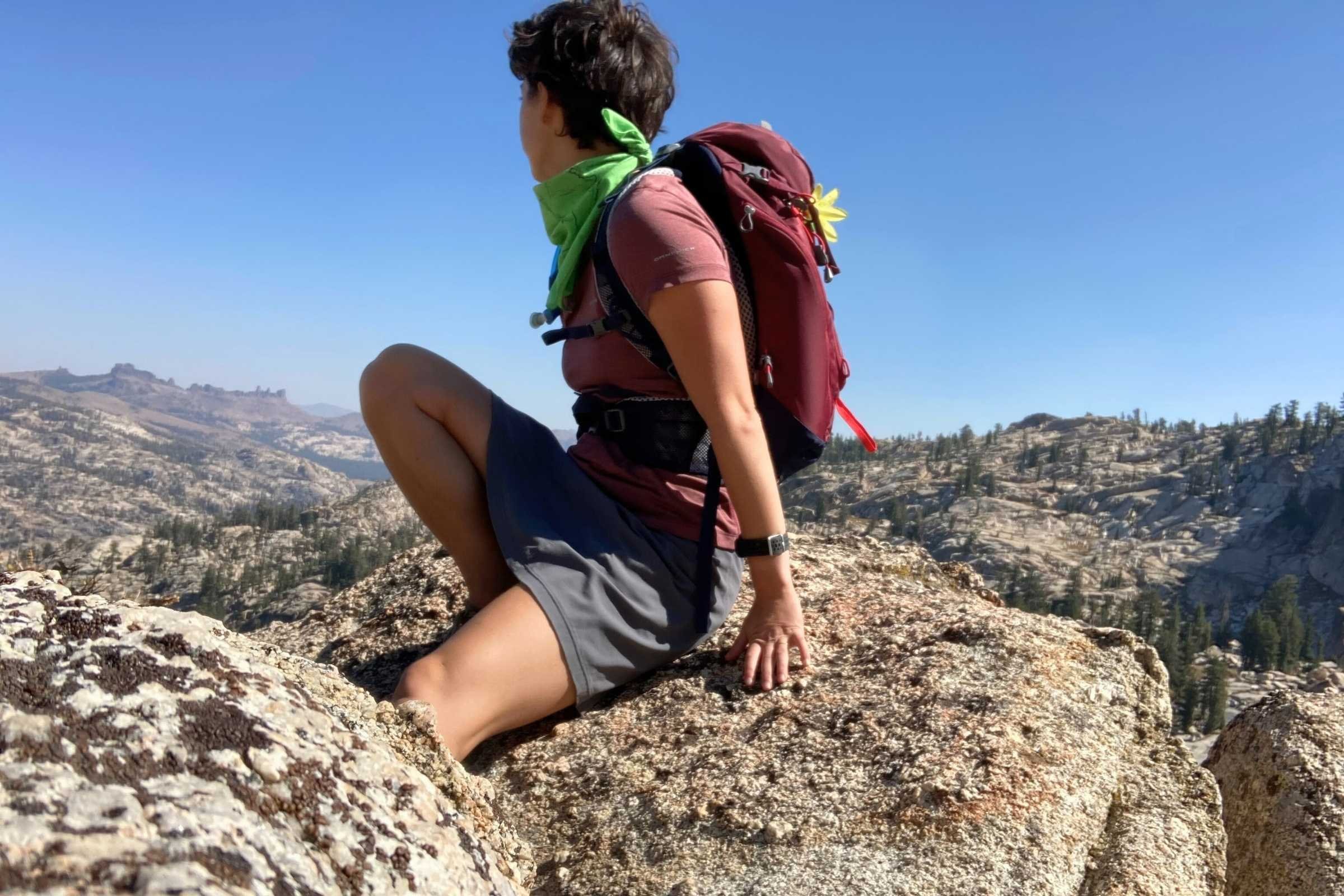



It has a spacious 28L capacity and multiple zipper storage compartments, including a hip pocket, side zipper compartment, and lid pocket (also called a “brain” — separate storage from the main body of the backpack that buckles over the top of the bag).
With adjustable straps for the wide waist belt and load adjustment shoulder straps, this pack can feel custom-made for a variety of female body types. We did note smaller persons might find themselves with excess waist straps flailing around after adjusting it to their hips. If so, simply cut off the excess and singe the ends of the straps with a lighter to prevent fraying.
While there are many things we love about this pack, we recognize for the hiker who just wants to crush miles, you probably want a more streamlined pack. Honestly, the Trail 28 could almost serve as an overnight pack for how spacious it is. If you’re only bringing a few layers, some snacks, and a water bottle — the Trail 28 might feel excessive.
All in all, the Deuter Trail 28L is a great selection for hikers who like to have the option of bringing a big load for a long day hike, women looking for a super comfortable fitting pack, or avid climbers and alpinists. —tested and written by Editorial Assistant Gianna Starble
Best Plus-Size Day Pack: Gregory Jade 28
Weight: 2 lb 8 oz
Fits waist: 39-60 in
Fits torso: 14-19 in
Capacity: 28L
Hipbelt: Yes
What we liked: ventilated back panel provides support without overheating, padded hipbelt with pockets that can fit phone,
What we didn’t like: only fits torsos up to 19" so may not work for taller hikers
I had to scour the internet to upgrade to a plus-size pack specifically made for day hikes. I wanted a pack that was relatively lightweight and reflective under a headlamp, with lots of pockets and the ability to hold my hydration bladder.
Although more brands are making plus size packs including Osprey and REI, I’ve found Gregory bags to be high quality and have stood through hard use both on and off the trail. After testing 7 plus-size backpacks, the Gregory Jade 28 has impressed me. I’ll be using it for years to come. You can read more about my testing process in my guide to Best Plus Size Outdoor Gear.
View the Gregory Jade 28
The Jade comes in an attractive color and is 28L, feeling much roomier than the other plus-size day packs that I’ve been testing for years.
Though roomier in feeling and appearance, it doesn’t feel too heavy over longer day hikes and weighs in at 2.5lbs when empty. I generally carry a fair amount of items, at least food and water and a first aid kit, on day hikes and they all fit easily into the Jade. It loads from the top and secures with a drawstring and a buckle snap that is adjustable to tighten the bag down.
The VaporSpan back panel has ventilated mesh panels that also provides anatomical support. I first tested the Jade in early May in Wyoming, where I shed and added layers as the day got warmer and colder during erratic weather. The ventilation worked excellently, and I didn’t end up with a sweaty back during the warmer parts of the hike.
My favorite part of the Jade lies in the hip belt, which has pockets wide enough for my Iphone 14 and truly left me feeling cradled. Unlike many extended fit day packs I tested, the belt fits like my backpacking pack, and the wide width feels ergonomic and supportive, helping me go further for longer. It didn’t cut into my stomach or waist and there was room to spare when closing.
The overall fit is equivalent to a 2-6X in clothing size and with many adjustable features at the shoulders and waist make it easy to fit every size in the range. All in all, we hiked ten miles that first testing day and the Jade performed excellently. I’ll be using it for the rest of the summer and probably for much longer than that. - Review by Treeline Review writer Gabi Reyes-Acosta
Other hiking daypacks we tested
Camelbak Arete 18
Weight: 12 oz
Fits waist: n/a
Fits torso: 15-21 in
Capacity: 16.5 L
Hipbelt: No
What we liked: The Arete’s small size means it can serve as the reservoir sleeve of a larger pack in a pinch
What we didn’t like: Limited weight carrying capacity
The Camelbak Arete 18 is designed to be a packable daypack — one that can roll up in luggage or bring inside of a bigger backpacking backpack to bag summits or head to the lake from your basecamp. It’s a minimal pack specifically called by Camelbak a “hydration pack for hiking.”
The Camelbak Arete can handle water in the hydration sleeve, and maybe a jacket or other light items — but any serious weight in this pack caused our testers discomfort in the shoulders.
Compare prices of the Camelbak Arete 18
The Camelbak Arete lets you carry up to 1.5L of water. Photo courtesy of Liam Purtle
While I liked the Marble color when looking at it online, I found in person that it looks a lot more like camo than the internet pictures suggest. It’s one of the lightest packs we considered at 1 lb 8 oz. It’d be a good option to fold up inside of a travel bag or perhaps carry as a second summit bag on a backpacking trip where you’re base camping. We also think it’s a festival-ready pack providing the space you need for water and an extra layer, but little else. Overall, it’s a decent daypack, but I’d much rather wear a running vest if hydration is the only thing I’m worried about.
We toyed with testing the Camelbak Fourtneener, a similar daypack with a 26L capacity. However, customers complained that the drink tube (that comes with the pack) wasn't long enough. The single zipper to access everything (vs. a more common double zipper on most packs) also impacted durability on the Camelbak Fourteener.
Weight: 14 oz
Fits waist: n/a
Fits torso: 15-21 in
Capacity: 24L, also comes in 18L
Hipbelt: No
What we liked: Color combo, multi uses
What we didn’t like: Closure system, shoulder straps
The Cotopaxi Luzon Del Dia was a bit confusing. The pack has two separate compartments: a small, zippered enclosure, and the main body of the pack, closed by a drawstring. The zippered pocket — the more secure of the two — feels too small to fit anything substantial. The drawstring on the main body of the pack made it hard to close (and keep closed) when pushing the pack to its limit. Additionally, the drawstring closures never fully shut. If there’s any precipitation at all, whatever is at the top of your pack will get wet.
Compare Prices Of The Cotopaxi Luzon Del Dia 24
The Cotopaxi Luzon Del Dia was the second lightest weight pack we considered at 14.4 oz with the best weight to volume capacity of any pack we considered. While I love the colors on the pack, the Luzon Del Dia feels more aesthetically pleasing than trail-oriented.
We loved the fun color combinations of the Cotopaxi Luzon Del Dia. Photo courtesy of Liam Purtle
Weight: 14 oz
Capacity: 22L
Hipbelt: Yes
Fits waist: 26-42 inches
Fits torso: 16-21 in
What we liked: Value for price, recycled nylon (bluesign®-approved)
What we didn’t like: Doesn't work as well for tall and wide people, not much shape, structure, or support making it difficult to place heavier items in here
The REI Flash 22 series is an affordable and popular daypack. It's a lightweight backpack designed to give you everything you need without extra padding. It compresses down well so won't take up room in your gear closet and can easily be brought inside of other luggage. At 4.8/5 stars and no 1- or 2-star reviews, it has among the best customer feedback of any pack we've seen. We think the Flash 22 is a good option for short hikes. But for longer hikes and heavier loads, you'll want something with more structure. Its shoulder padding leaves something to be desired.
View the REI Flash 22
Weight: 1 lb 13 oz
Capacity: 25 L
Hipbelt: Yes
Fits waist: 28-46 in
Fits torso: 16 - 20 in
What we liked: Value for price, recycled nylon (bluesign®-approved)
What we didn’t like: Pocket placement could be better
The REI Trail 25 is an affordable daypack that's a step up from the REI Flash. It has more structure with an HDPE framesheet and 2 additional pockets. It has great reviews at REI with 5/5 stars over 25 customers. However, despite the number of happy users, we found a few design issues with this pack that steered us towards options by other brands.
First, the shoulder straps look similar to those on the REI Trail 22, a much more minimal backpack. For a pack with a framesheet, we'd prefer wider and more padded shoulder straps. It also doesn't have a padded hipbelt, just a strap of webbing. The hipbelt is for stabilizing more than carrying weight. In an older model of this pack, customers complained the the framesheet wasn't rigid. The newest version doesn't appear to have improved the framesheet, but it does use bluesign certified fabric now.
View the REI Trail 25
Putting the daypacks we researched to the test. Photo courtesy of Liam Purtle
What to look for in a hiking daypacks
There are many things we look for in a daypack. Some of the best daypacks are versatile enough to do it all. But sometimes having a specific daypack for your specific needs can save weight, time spent searching for that lip balm you put somewhere — and money, too.
Daypacks need to be comfortable, affordable, and have the features that fit your needs. Below are different features to consider when selecting your ideal daypack. Know that whatever works for you, works for you — your needs are as unique as you are, so don’t feel the urge to settle for something that’s not ideal.
Fit & Comfort
One of the most important aspects to picking a daypack is the fit. This will be the deciding factor between a comfortable, fun day on the trail and a miserable day on trail. You want a pack to feel like you can hike up an incredible summit, but also to feel good for a casual day in the park, too.
Take your time selecting a daypack. Check out multiple types — all daypacks have different pros and cons, so make sure you find a balance that works for you. You also want to make sure you’ve got enough room for what you carry, and that the build of the pack isn’t too big or too small for you. Too big could cause uncomfortable rubbing. Too small could cramp your back or shoulders. Try before you buy, if you can — or plan to take advantage of generous return policies, like the one at REI.
Think of how you will use your pack when considering which one to buy. Photo courtesy of Liam Purtle
Use
How and where are you going to get the most use out of your daypack? Are you going to be using this pack for backcountry hiking, mountain biking, climbing, skiing, snowboarding, casual hikes in the frontcountry, or even commuting to work? Are you looking for a jack-of-all-trades pack — like the Osprey Talon 22L, our Best Overall Daypack — or something a little more specific to hiking and weekend trips, like the Six Moon Designs Wy’east 34L?
Say you’re looking for a pack to come along as you hike exposed routes in the mountains — you might want to look for a pack that can hold a helmet to protect you from falling rocks, or that has a loop and bungees for an ice axe. Or if you sometimes find yourself hiking at night, you might want to consider a brightly-colored pack, or one with built-in reflective materials, so it’s easy to spot after dark. Whatever you’re up to, your daypack should be able to meet those challenges.
Price
Backpacks meant for multi-day trips can sometimes break the bank, but you shouldn’t have to take out a loan for a daypack. A good daypack will run anywhere from $50 to $200 — we definitely don’t recommend spending any more than this — but solid daypacks can be found in the $100 dollar range. If your daypack is going to see weekly or more frequent use, consider spending a little more for a pack with the exact features you want — and that will last for many years and even more miles. For infrequent use, or more of a focus on commuting, a standard daypack will get the job done just fine.
For example, I’ve personally been using a Patagonia Refugio for about 5 years now. The Refugio pack has taken me from college classes to the Sahara Desert on camelback. So while my lifestyle hasn't been all mountains all the time, any good daypack will carry what you need for adventures in town and in nature.
Out on the trail with the Osprey Stratos. Photo courtesy of Liam Purtle
Features
Once you’ve settled on the purpose of your daypack, it’ll be easier to figure out your own personal need-to-have and nice-to-have features. How much can the pack carry, both in terms of volume and weight, while still being comfortable? Do you need a hip belt, and is the hip belt on the pack supportive enough for your needs? How is the ventilation — on the back of the pack, and under the straps — on a hot day? Are the shoulder straps thick and comfortable rather than too narrow or pinchy? Is there a hydration sleeve for a water bladder if that’s a feature you’re looking for — or can you remove it if you don’t need it?
There are many choices when it comes to a great daypack. Photo courtesy of Liam Purtle
Capacity
How big should a daypack be? Ask ten people, get ten answers — but we recommend getting your other hiking gear in order before you buy your daypack, so you know how much you need to fit inside. Most daypacks on our list range from anywhere from 17L up to 34L. The size you select should be based on your intended use for the pack. Do you want to take your daypack on longer, more intense hiking routes? Or are you looking for something to commute to the office with everyday, and come Saturday, take a really great day hike?
If you’re only planning on doing single-day, out-and-back hikes close to home, consider a smaller daypack or even just a hydration pack that can fit enough snacks for a few miles. If you are intending on using your pack for longer hikes farther afield, where you will need to carry extra food, more water, rain gear, or climbing gear, you might want a daypack with a greater carrying capacity.
Testing packs on sandy shores. Photo courtesy of Liam Purtle
Weight
There are two components to consider when it comes to weight: the actual weight of the pack and the weight the pack can carry.
Some daypacks are heavy — sometimes heavier than they need to be for their usage. If you’re commuting to work or taking on smaller day hikes, then lighter packs are often better. On the other hand, if you’re looking to carry a high volume (like down jackets) or heavier gear to summit some Class 4 peaks, then a pack the weight of an internal frame pack might be necessary. That extra weight could be fabric to make the pack more rigid, a foam or metal frame, or a hip belt for distributing the weight you’re carrying.
The daypacks in our review ranged from 10 oz to 3 lbs 1 oz. The Deuter Trail 28 SL was the heaviest pack we considered with a lot of features like an internal frame and cushioned padding. The Osprey Stratos was the heaviest pack that made it to the testing round at 2 lbs 12 oz. The Camelbak Arete was both the lightest pack that made our shortlist and the lightest that made it to the testing round. It weighs 10 oz and was the most streamlined of the packs.
In terms of the weight the pack can carry, a pack should always be one of the last things you buy — you’ll know how much weight you need the daypack to be able to carry once you know what you’re going to put inside it. Once you have an idea of the weight, try to head for a store like REI where you can load the pack with weight and see how it feels to carry. If it’s not comfortable, you’ll find it sitting in the back of your closet more often than you use it. The daypacks in our review have carrying capacities between 10 and 25 pounds, with the weight of the pack itself having some correlation to how much weight it can carry.
We went high and low to test the daypacks for this review. Photo courtesy of Liam Purtle
Hip Belt
Is a hip belt on a daypack necessary? It depends. Hip belts distribute some of your pack weight to your hips, creating a more comfortable experience for your shoulders. If you’re carrying under 10 pounds, a hip belt may not be necessary — but if you can take any weight off your shoulders, they’ll thank you for it later.
Some daypacks, like the Osprey Stratos and the Hyperlite Mountain Gear Daybreak, have very sturdy hip belts (and additional hip belt pockets to boot). You’ll be able to comfortably carry more weight in a daypack with a hip belt than you would in one without. The more robust the hip belt, the heavier that weight can be. If you plan to carry heavy gear, a change of clothes, or extra food, I would definitely recommend a sturdy hip belt.
But do you need a hip belt to carry your laptop and lunch to your day job? Probably not. In fact, sometimes hip belts can get in the way of day-to-day use (I’ve caught my hip belt strap in the car door more times than I can count). Packs with hip belts that can be removed or hidden, like the Six Moon Designs Wy’east, might be better suited to being both an office bag and a great daypack for hiking, too.
Having a sturdy hipbelt on a daypack can be a make or break feature for a hiker. Photo courtesy of Liam Purtle
Shoulder Straps
A good shoulder strap can be the difference between an ordinary hike and an uncomfortable week of tight shoulders after a hike. The thickness and build of a shoulder strap should be related to the weight the pack was designed to carry: a thinner, less-cushioned strap is likely meant to carry 10 pounds or less, where a thicker, cushioned, or even contoured strap tells you the pack can take a little more weight. We found the best straps to be on the Six Moon Design Wy’east, the Hyperlite Daybreak, and the Osprey Talon and Stratos. While it might seem silly to pay such close attention to detail, trust your gut. If the pack’s not comfortable when you first put it on with all the tags attached, you’re not going to use it for long on the trail.
Some shoulder straps also have really great features, like the ability to hold your phone, keep your hydration hose close to hand, or clip your trekking poles in when you’re not using them. Packs like the Osprey Talon, Osprey Stratos, and Six Moon Designs Wy’east have many features listed above. Consider these bonuses rather than expectations — they generally add more weight to a pack — so keep an eye out for these extras if they’d add to your daypack experience.
Internal Frame & Ventilation
Daypacks will either be frameless, have a back panel, or feature an internal frame. A frameless or soft-backed pack is going to have no extra support or padding for your back, like the Cotopaxi Luzon Del Dia. This usually lends for a lightweight pack and might be preferred for someone who doesn’t take much with them while hiking. Daypacks with a back panel will have a layer of padding and sometimes feature breathable ventilation construction, like that of the Patagonia Refugio. A back panel daypack will make hiking more comfortable and add a buffer between your back and any clunky items you may be hauling.
Pockets that fit your water bottle is an important feature. Photo courtesy of Liam Purtle
An internal frame will provide the most support. Usually made from aluminum stays, plastic frame sheets, or curved Delrin rods and built into the pack itself (hence, the name internal frame). A well-suited internal frame will fit snuggly to your back and help distribute the weight of your load so it’s not completely on your shoulders. For example, the Osprey Tempest 22 features an internal frame along with a ventilation back panel on the exterior — so you can take heavier loads without your back getting too sweaty. The more rigid the frame, the more support you’ll have — and the more (and more bulky) stuff you’ll be able to bring along comfortably. Frames do make the pack heavier, however, so if you’re just carrying some extra layers, water, and snacks, you won’t need much of a frame to make that load comfortable.
When thinking about ventilation, think airflow and sweat management. Packs you can comfortably sweat in usually have foam or mesh as a part of the outer back panel, or built-in channels where air can seep in. Alternatively, the back panel itself will hold the main body of the pack away from your back, like with the Osprey Stratos 24 and Talon 22. If the pack doesn’t have either of these features, you can generally assume that the pack is overall going to be carrying lighter loads — and less prone to making you sweat — than one with great ventilation.
Before purchasing your daypack, ask yourself: will this pack support my intended gear/equipment, and how well insulated or ventilated will my back feel in this pack? We liked the way Garage Grown Gear breaks down the difference between frameless and internal framed backpacks.
Durability
Durability is something we look for in all of our outdoor gear, but it’s especially important with backpacks. A good pack, whether it’s for long distance backpacking or day trip outings, should be able to take some abuse on the trail and last for many years. Look for abrasion-resistant fabrics like high-denier nylons and polyesters, among others. Durable fabrics help the pack to resist tears, holes, and snags that could come from branches, sharp rocks, or anything else you might find on the trail. It’s also important to have quality zippers and components. Most reputable brands (including all of our winners) are known for designing quality gear. If you want your pack to be durable and last many years and miles on the trail, spending a little more on a pack from a well-known outdoors brand is usually worth it.
Weather resistance
Most daypacks offer at least some form of weather resistance, though they are not typically fully waterproof (and that’s usually not necessary for hiking). Look at the details of the material to see if there is a DWR (durable water repellent) coating on the outer fabric that will help to shed moisture and precipitation when you’re hiking—even better if the treatment is PFC-free, limiting the harmful chemicals used in the materials.
Certain daypacks come with a compatible hydration sleeve, like the Deuter Trail 28SL pictured here. Photo courtesy of Gianna Starble
Water Bottle Pockets And/Or Hydration Sleeve
Water storage is one of the most important parts of a daypack. Make sure the pack you select has the ability — through pockets, a hydration sleeve, or inside the pack itself — to carry enough water for your intended use.
Ideally, make sure the pockets fit your bottles — pockets that are too big mean the bottles will shift around as you walk, and pockets that are too small might mean taking the pack off every time you need to take a drink. We found the best pockets to be on the Hyperlite Daybreak, the Six Moon Designs Wy’east, and Granite Gear Dagger daypacks.
If you prefer to use a hydration bladder with a tube that winds its way out of the pack and into your mouth, make sure your current system fits your new pack’s hydration sleeve — or you’ll be buying bladders, too. The Six Moon Designs Wy’east, Granite Gear Dagger, Osprey Talon and Stratos daypacks have a specific hydration sleeve, but if you’re willing to risk some disorganization, you can use a bladder in nearly any daypack.
Having hipbelt pockets can be super handy to store items like a snack or lip balm. Photo courtesy of Gianna Starble
Interior Organization
Once your daypack is packed, you want to be able to find everything easily. The more time you spend digging for sunscreen, the less time you’re spending enjoying your surroundings.
Some packs have different internal compartments that keep things organized and accessible. The Hyperlite Daybreak has a small internal pocket for valuables. The Osprey Talon also has a great mesh internal pocket which I found great for my keys, wallet or anything I don't want to get lost within the larger compartment. These internal pockets differ from Hydration sleeves because you can tell they have more purpose than water. They are meant to keep things separate from other items. External pockets should carry things that could be necessary quickly, like a headlamp or a rain jacket. Having multiple pockets is great for keeping dirty and wet things separate from your clean and dry items.
While having pockets is great, more pockets mean more material is being used — meaning the pack itself is going to be heavier. If you are trying to keep things minimalistic, opt for a simpler design, like the Six Moon Designs Wy’east 34L or the Hyperlite Mountain Gear Daybreak 17L.
Your daypack choice should reflect the type of adventures you’ll be taking it on. Photo courtesy of Liam Purtle
Closure System
Some daypacks close by using a simple zipper, like your average backpack. Other, more minimalist packs may use a drawstring or more simple way of closing.
Zippers will keep what’s on the inside drier than a drawcord, but drawcords are great for quick access and overstuffing your pack if you need to. (If you buy the right capacity for you, however, you likely won’t need to.)
The Hyperlite Daybreak has one of the best zipper closures on a pack I’ve ever seen. The zipper is very airtight — so I assume my stuff will stay drier than in a Cotopaxi Luzon Del Dia, which has a drawstring closure.
While zippers are great for keeping stuff dry, they are both heavy and mechanical — so they add weight to a pack and eventually can break.
It’s possible that, over time, a roll top or drawstring pack may have fewer problems, but keeping your zippers clean and dry can do much to extend the life of your pack. Check in with manufacturers, too — brands like Osprey have lifetime warranties and will repair or replace anything that breaks.
How to choose a backpack for hiking
Comfortable shoulder straps are a must for a solid daypack. Photo courtesy of Liam Purtle
Selecting a pack for hiking depends on many factors, including budget, the size of pack you need, and the type of terrain you’ll be hiking in.
There are numerous options out there for hikers with a range of budgets. Know that when considering a pack specifically for hiking, a higher price tag often means you get more features, quality, and/or durability with that pack. So it’s good to balance your budget with what you can afford, while also looking for a quality pack that will last a long time.
It’s also important to consider the size of the pack you need. Many daypacks for hiking come in a range of 15-25L in volume (though there are options for smaller and larger packs). This seems to hit a sweet spot for most day hikers — leaving space for snacks, water, and gear without being too large. If you’re hiking in environments where more gear is necessary (like extra layers for winter and cold conditions), you may want a larger pack to accommodate that gear. If you prefer to go light and fast, a smaller pack may be suitable for you.
Daypacks for hiking also come with a variety of features, from hydration bladders to ice ax carry loops and helmet straps. Think about what types of hikes you’ll be on and in what environments to help you decide what features should be a priority.
How much gear (volume and weight) will you be carrying?
Maybe you’re a light and fast hiker who needs only the bare essentials and a smaller pack. Or perhaps you love to carry lots of camera gear, like to have plenty of layers, or have a family with a constant need for snacks. Thinking about how much gear you’ll need to carry for most of your hikes will help you to decide on what volume pack is best.
What season are you hiking?
While this isn’t always the case, warm weather hikes often require you to carry less gear than when you’re out in the cold and snow. Do you need space for extra layers, gloves, and other gear? If you have only one daypack, it can be helpful to find one with good compression straps and a little extra volume. This means you can stuff the pack to the brim when you need to, but when a hike doesn’t require as much gear, you can cinch down the straps so the pack doesn’t feel bulky and floppy when it’s not fully loaded.
How much water will you need?
Most backpacks for day hiking have features for carrying water, whether that’s in the form of bottle pockets or a hydration bladder, or both. If you like to have constant, easy access to water without fiddling with bottles on the trail, look for a pack that’s compatible with or comes with a hydration bladder, that way you can sip as you hike. If you often need to carry a lot of water on your hikes, look for a pack that has multiple options for carrying water, like a hydration sleeve and dual bottle pockets. And a little extra volume can be helpful here, too.
Do you want a foldable pack or want something with more structure?
Some backpacks are themselves packable, which makes them easy to bring along for travel that’s not just to the trailhead and back. These packs are often more minimal, lightweight, and easy to stow away, but they often have lower volumes and less structure and support. If you prioritize capacity and carrying comfort, look for a pack with more structure and a sturdy frame and back panel. But if you want something simple and easy to transport, look for a pack on the lighter and smaller side.
How much does ventilation matter to you?
One pack feature that’s worth considering is ventilation. Some packs have designs that lay flat on the back without much special on the back panel, while others have specialized airflow and venting systems to help minimize sweat on the trail. If you often hike in warm and hot climates, or you just hate back sweat, look for a pack with this feature. But you may have to compromise on price and other things, like weight or packability to get this.
FAQ
-
Daypacks are small (10 – 35 L) and built for single-day hikes, so they skip bulky frames and sleeping-bag space. Overnight backpacking packs (40 L+) add load-bearing frames, larger hip belts, and room for tents, pads, and cooking gear—features that feel cumbersome on short outings.
-
For most day hikes, a 20- to 25-liter pack holds water, extra layers, lunch, and safety gear without excess bulk. Ultralight trips might use 10–15 L, while gear-heavy outings (winter, kid-toting, photo rigs) may need 30–35 L.
-
Measure your torso length (C7 vertebra to iliac crest) and choose the size range that matches. On trail, fasten the hip belt first—centered on the top of your hips—then snug the shoulder straps so the pack hugs your back without lifting the belt. Fine-tune with load lifters and sternum strap.
-
You can, but you’ll miss trail-specific perks: ventilated back panels, hydration-hose ports, trekking-pole loops, water-resistant fabrics, and cushioned hip belts. Frequent hikers will stay cooler and more comfortable in a purpose-built daypack.
-
Loosen everything, shoulder it, then:
Hip belt snug on hip bones
Shoulder straps just tight enough to remove gap
Load lifters (if present) at a 45° angle to bring the pack body toward your shoulders
Sternum strap lightly tensioned to keep straps from splaying
Most weight should rest on your hips, not your shoulders.
-
Yes. Women’s models offer shorter torso options, S-curved shoulder straps, and shaped hip belts that contour around the bust and hips. Try both “women’s” and “unisex” versions—go with whichever fits best regardless of label.
-
Only if your kit is ultralight. A sub-35 L pack generally lacks volume for a sleeping system and stove, and its suspension may become uncomfortable above 10–12 kg (20–26 lb). For most overnight hikes, use a 40- to 65-liter backpacking pack.
-
Keep a daypack under 10 % of your body weight for comfort; most hikers stay below 9 kg / 20 lb. Check manufacturer max-load specs—minimalist packs aren’t designed for heavy water hauls or climbing hardware.
-
Many daypacks use water-resistant coatings, but sustained rain will soak seams and zippers. A lightweight pack cover (often sold separately) or a trash-bag liner keeps insulation layers and electronics dry on wet hikes.
Care and maintenance tips for hiking daypacks
You may not think it matters much, but regular cleaning is essential to keep your hiking daypack in good condition. Luckily, it's pretty simple. After each hike, empty the pack and shake out dirt and debris. Wipe the interior and exterior with a damp cloth to remove any remaining dirt. That's it.
For a more thorough clean, occasionally submerge the pack in a bathtub or large sink filled with lukewarm water and mild soap. If it's really dirty, gently scrub it with a soft brush. Either way, rinse thoroughly, and hang it to air dry, avoiding direct sunlight.
If your daypack has any stains from food, pine sap, or dirt that difn't wash out, using a mild detergent or specialized outdoor gear cleaner works best. Apply the cleaner with a sponge or soft brush, and rinse well. For the worst stains, let the detergent sit for a few minutes before scrubbing. Zippers should be kept clean and free from dirt and debris. Using a toothbrush to clean the teeth and applying a zipper lubricant occasionally will ensure they operate smoothly.
Straps and buckles should be checked regularly for wear and tear, and any damaged parts should be replaced to maintain the pack's stability and comfort. Ensure all straps are properly adjusted and tightened to avoid unnecessary stress on seams and fabric. To maintain waterproofing, apply a waterproof spray or treatment periodically, especially if the pack is frequently exposed to wet conditions. Additionally, using a pack cover or dry bags can protect your gear from rain.
Store your daypack in a cool, dry place, avoiding direct sunlight or damp areas to prevent fabric degradation and mold growth. Stuff the pack loosely with paper or cloth to help it maintain its shape. It's also important to avoid overloading your pack. Follow the manufacturer's recommended weight limit to prevent damage to seams and zippers, and distribute weight evenly to avoid putting excessive stress on specific areas.
Regular inspection of your daypack for signs of wear and tear, such as frayed seams, worn-out fabric, or damaged buckles, is important. Address any issues promptly to extend the lifespan of your pack. Carrying a small repair kit with essential items like fabric patches, a needle and thread, and extra buckles can be a lifesaver for on-the-trail fixes. Protect your pack from prolonged exposure to UV rays, as they can weaken the fabric. When not in use, store your pack in a shaded area or use a cover to shield it from the sun.
We searched high and low to curate a list of awesome daypacks we love. Photo courtesy of Liam Purtle
How We Researched
We researched the top 13 comparative reviews on day-hiking backpacks from Section Hiker, Switchback Travel, Outdoor Gear Lab, Gear Patrol, Backpacker Magazine, Popular Mechanics, Cool of the Wild, Mountain IQ, Bearfoot Theory, Gear Junkie, and Outside Magazine.
We also considered the highest-rated daypacks at outdoor retailers like REI, Backcountry.com, and Amazon. Based on these reviews, we developed a list of the 64 most popular day-hiking backpacks.
Then, we narrowed that list down to the 12 packs that received the highest ratings. We took into account the number of reviewers that gave it high marks and their relative rankings from these reviewers.
From there, I tested all of the shortlist contenders in the field on day hikes in Michigan, Illinois, and Utah. We also had a variety of testers with different body shapes and sizes, as well as different levels of experience, give us feedback. Then, I compiled all that feedback into this review.
Author’s Expertise: Why You Should Trust Us
The author hiking the PCT. Photo courtesy of Liam Purtle
My name is Liam “Hot Take” Purtle and I thru-hiked the Pacific Crest Trail in 2019. Since finishing the trail, I’ve resumed being an active day hiker — from where I lived in Chicago and on Midwest trails to my move to Utah and trails in the Unitas and Wasatch Range. I’ve also covered The Best Thru-hiking Shorts for Treeline Review.
To represent a variety of bodies, styles, needs, and experience levels, I also reached out to my fellow community of hikers, but also friends who would never call themselves “hikers” but wanted to walk to the lake. The winners in this story trail-tested and loved by gear nerds and gear newbies alike.
While on the PCT, I was featured in Outside Magazine and the Stories from the Trail Podcast. Since finishing my hike, I’ve spoken about hiking at the Patagonia store in Chicago.
During my PCT hike, I raised almost $2500 to diversify outdoors focusing on two organizations that are important to me. Out There Adventures is an organization that fosters positive identity development and empowerment for queer young people through outdoor adventure education. Soul Track Outdoors is a D.C. based nonprofit that connects communities of color to outdoor spaces while also building a coalition of diverse outdoor leaders
It is important to mention that neither myself or any of my family members are sponsored, ambassadors, or an employee of any of the companies mentioned here. This is an unbiased review, and we do this to help find the best product for the job and price. Treeline Review doesn’t accept sponsored content, native advertising, or paid reviews.

